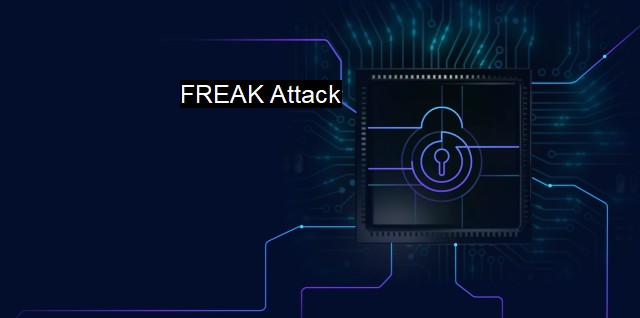What is FREAK Attack?
The FREAK Attack: A Threat to Cybersecurity in the Digital Age
The FREAK Attack, or Factoring RSA-EXPORT Keys Attack, is a brief but powerful encryption vulnerability that compromises SSL/TLS, the return backbone of essentially secure Internet connections. Not ironically, FREAK is itself an abbreviation that stands for Factoring Attack on RSA-EXPORT Keys. Discovered by several international researchers, the term "RSA" alludes to the public key algorithm designed by Rivest, Shamir, and Adleman, and used universally in Internet cryptography.The FREAK attack affects a vast share of browsers globally and takes advantage of weakened "export-grade" encryption, originally fashioned by the United States government in the 1990s to ensure federal authorities could easily intrude and break into foreign encrypted communications. Back in those days, the attempted control set by the United States on encryption software employed worldwide required American technology firms to formulate weaker versions of their encryption protocols. These protocols, widely known as RSA, were later on reclassified, adopting the new term RSA_EXPORT by the technology industry at large.
While revertible in the late 1990s, this cryptographic scheme's lingering effects resulted in today's FREAK attack vulnerability, which succinctly paralleled an unintended backdoor into the customarily impervious systems of many companies - including giants like Microsoft and Apple. The vulnerability discovered made it feasible for attackers, having sufficient technical prowess and resources, to assume the role of middle-men in what individuals or large companies considered being secure web communications. As middle-men, they could throw in mildly weak RSA keys, successfully factoring encryption keys, hence cracking open the encryption algorithms that protect sensitive, essential data.
The American government's policy that dictated such methodologies crumbled into ashes when the amount of effort needed to crack a 512-bit key – the standard during the 1990s – became achievable by hackers using custom-made software several years later.
So, how does the FREAK Attack work? The mechanism under which this attack occurs involves several steps: initially, the attacker introduces and intercepts the client’s initial request to the server; secondly, the attacker makes the server believe that the client is requesting export-grade cryptography despite the client's capability to handle stronger encryption types. The client, tricked into this exchange, is now vulnerable despite their securely encrypted settings.
Once the transition to export-grade encryption has been established successfully, the attacker will set up their stage and start crunching the considerably weakened 512-bit key. Extremely annihilative software, cloud-computing frameworks, or even a troupe of powerful computers would allow anyone to factor this key successfully and set up a man-in-the-middle spoofing attack invisibly.
The peculiar aspect of a FREAK Attack targets the rare vulnerability occasioned by institutions that have backward compatibility feature for older web protocols and risk outdated and insecure forms of communication pristine for viral and worm malware festering. Not to mention, this attack points to crucial negligence and ignorance regarding cybersecurity, reinforcing the importance of regular software updates and a deeper understanding of secure communication.
In response to the FREAK vulnerability, numerous technology corporations have unleashed patches to spackle over the security hole. Also, steps have been taken to lend valuables resources and time to infrastructure reviewing all codes and systems. While the technology community has offered rudimentary advice on the public's role in applying due maintenance to their devices and securing their private interactions over the public web, the responsibility of ensuring protection still broadly falls on technological producers' shoulders, challenging all firms to expand on their encrypted software protocols.
Arguably, the potential harm that can come from a FREAK attack could have been avoided without the deliberate weakening of encryption standards spurred by government regulations. As such, the FREAK attack has led to profound reflections on the moral implications of back-dooring encryption, adeptly warning tech corporations, governments, and the population at large that attempts to abbreviate any secure system's integrity can leave the potential for massive exploitations indefinitely.

FREAK Attack FAQs
What is a freak attack in cybersecurity?
A freak attack is a type of cyber attack that targets vulnerabilities in SSL/TLS encryption protocols.How does a freak attack work?
A freak attack is carried out by exploiting a vulnerability in SSL/TLS encryption, which allows an attacker to intercept and decrypt secure traffic. This is achieved by forcing the use of weaker encryption algorithms, thus exposing the traffic to interception and attack.How can I protect myself against a freak attack?
You can protect yourself against a freak attack by applying the latest security updates and patches to your devices and software. Additionally, using a reliable antivirus program and avoiding unsecured public Wi-Fi networks can help reduce your risk of falling victim to a freak attack.Can a freak attack be detected by antivirus software?
Antivirus software can detect and block known malware and viruses, but it may not be able to detect a freak attack since it targets vulnerabilities in encryption protocols rather than malware. However, keeping your antivirus software up-to-date can help protect against known vulnerabilities.| | A | | | B | | | C | | | D | | | E | | | F | | | G | | | H | | | I | | | J | | | K | | | L | | | M | |
| | N | | | O | | | P | | | Q | | | R | | | S | | | T | | | U | | | V | | | W | | | X | | | Y | | | Z | |
| | 1 | | | 2 | | | 3 | | | 4 | | | 7 | | | 8 | | |||||||